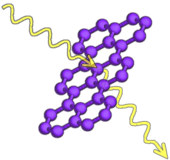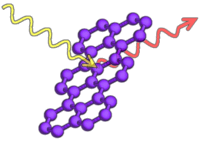This page provides a very much simplified discussion of the interaction between light and molecules. We only concern ourselves with aspects that are relevant for the understanding of the principles of single-molecule optics which are presented in the following chapters. (A more rigid treatment of most of the topics introduced here can be found in “Molecular electronic structure and photophysics”.)
Scattering

Scattering is a very general phenomenon which can occur via different mechanisms, depending on the size of the scatterer as compared to the wavelength of the radiation. For molecules – which are in general much smaller than the wavelength of light – the efficiency of the relevant process is inversely proportional to the fourth power of the wavelength. Speaking in terms of photons, scattering can be viewed as an interaction which changes the direction of the photon while the molecule accepts the concomitant recoil. Scattering can be elastic – when the energy of the photon is conserved – or inelastic, leading to a change of the photon energy.
Excessive scattering can make it very difficult to collect and detect the emission of a single molecule. Any structural inhomogeneity of a solid on a length scale from about 100 nanometers to some tens of micrometers can in principle act as an additional scatterer, and great care has to be taken in the preparation of single-molecule samples in order to suppress scattering as much as possible.
Absorption spectroscopy
An incident photon can also be absorbed by a molecule and then the photon energy is converted into an excitation of that molecule’s electron cloud. This type of interaction is sensitive to the internal structure of the molecule, since the laws of quantum mechanics only allow for the existence of a limited number of excited states of the electron cloud of any given chemical species. Each of these excited states has a defined energy; the absorption of the photon has to bridge the energy gap between the ground state (lowest energy state) and an allowed excited state of the electron cloud. Molecules can therefore be identified by their absorption spectrum: Their wavelength-dependent capacity for absorbing photons depends on the energy spacing of the states of their electron cloud. (Astronomers use absorption lines to determine the composition of stars, for example.) Molecules which strongly absorb visible light appear colored to the human eye and are therefore called “chromophores,” i.e. “carriers of color.”
Fluorescence detection

Although it is possible to detect the absorption signal of a single molecule directly, it can be done both easier and with higher sensitivity by using an indirect approach: If a suitable chromophore is chosen it will quickly re-emit the energy of (almost) each absorbed photon and for reasons that will become clear in a minute this emission signal can be detected very efficiently. To understand the emission properties of a typical single-molecule chromophore, we have to take a look at the lowest excited state of its electron cloud, the one which is energetically closest to the ground state. From this state the molecule can relax to the electronic ground state by transforming the excess energy into vibrations of the nuclei or by transferring it radiationlessly to the molecule’s surroundings, but it can of course also get rid of it by emitting a photon. This re-emission of the absorbed energy is called fluorescence; well-chosen single-molecule chromophores can have fluorescence yields of more than 90%. (Such a molecule is often called a “fluorophore,” because it is a “carrier of …” – well, you guessed it already.)
However, when a photon is emitted it does not always carry the full excess energy of the electronically excited state; the missing part still goes to the nuclei and the environment. Due to this partial energy loss a significant portion of the fluorescence emission occurs at wavelengths above the one that corresponds to the energy gap between ground and lowest excited state. Our excitation laser on the other hand will naturally operate at or below that very wavelength, since it has to provide a flux of photons which have sufficient energy to bring the chromophore to the excited state. The bottom line of this is: If we can find a way to selectively suppress the laser wavelength in our detection path, we will still see the wavelength-shifted fluorescence. Nevertheless we get rid of the major part of the background, which arises from elastic scattering of the laser and hence has the same wavelength. We will talk about the practical realization of this in the chapter about the principles of single-molecule detection, but first we want to invite you to a crash course in optical microscopy.


